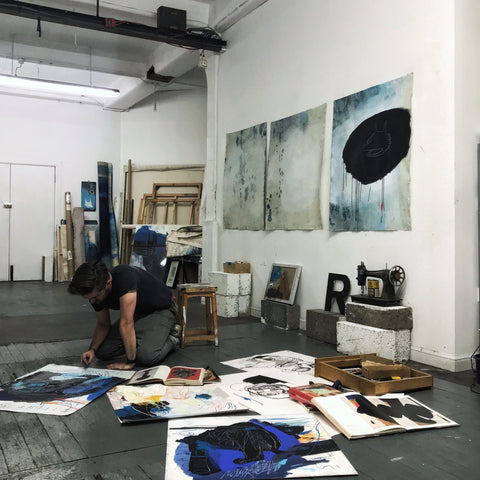Stewart Swan Interview | An Evolving Process
Posted by Kim Soep on

Stewart: ‘Clovis First’ is a large painting on canvas where I explore the hypothesis, debate and arguments among archaeologists about the people associated with the Clovis culture and whether they were the first inhabitants of the Americas.


‘Andrew’s Liver Salts’ is an example of where a found object, in this case, cardboard packaging, has directly influenced the theme of a painting. The found object became the source of inspiration that led me to research the history of the product and what it was used for. The finished painting illustrates my discoveries.
Kim: Who do you look to for inspiration?
Stewart: Jean-Michel Basquiat, Robert Rauschenberg, and Francis Bacon are my most prominent influences. Basquiat, for his vibrancy of colour, use of text and the playful spontaneity of his work, and Rauschenberg, for his use of found objects,- ‘Combine’ his series of hybrid paintings and assemblages have been particularly inspirational- while Bacon’s gesturing of the human form, achieving movement and emotion, is something I draw on frequently in my work.
I also really enjoy the graphic quality of Peter Blake and the compositional prowess of John Byrne. I can go on- Bellany, Hockney, Twombly, Eardley, Frankenthaler......
Kim: Do you take inspiration from other sources?
Stewart: I tend to take inspiration from encyclopedias, factual books, books about ancient civilisations and mythology.
When I’m working I often listen to music which can sometimes influence the mood and tone of the work I’m making.
Stewart: I like to visit old book shops, scrap, and architectural salvage yards to collect objects and surfaces on which to paint. The material or surface tends to influence the direction of which painting or drawing takes. Sometimes I make a collage of found elements to create a new surface. I rarely use a conventional canvas or paper- I find them a bit intimidating.
Acrylic paint, charcoal, oil pastel, and pencil are my other tools.
Kim: Talk us through your practice.Stewart: I seldom plan or produce preliminary drawings before starting a new piece. My paintings are normally a response to something I have read or heard.
Usually, I start painting or drawing with a flurry of colour and gestural mark-making. Then, I’ll attempt to form something tangible from the wreckage before me. It’s an evolving process of adding then editing.
I still enjoy the game where you make a scribble and challenge yourself to turn it into something recognisable. It forces you to look and discover possibilities within chance marks and happy accidents. The theme, narrative, and composition tend to reveal themselves and evolve along the way. I find that the longer I labour over a painting the less satisfying the outcome. For me, the first hits are often the most honest and gratifying.
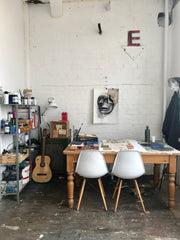
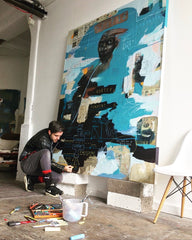
Kim: Describe your studio and its location; is it far from home
Stewart: My studio is located at Crownpoint Studios in Bridgeton, about a 15-minute walk from my flat in Dennistoun in the east end of Glasgow.
The building used to be used for steel manufacturing and has large south-facing windows. I work alone, sometimes at a desk but usually on the floors, or with canvas pinned to the wall.
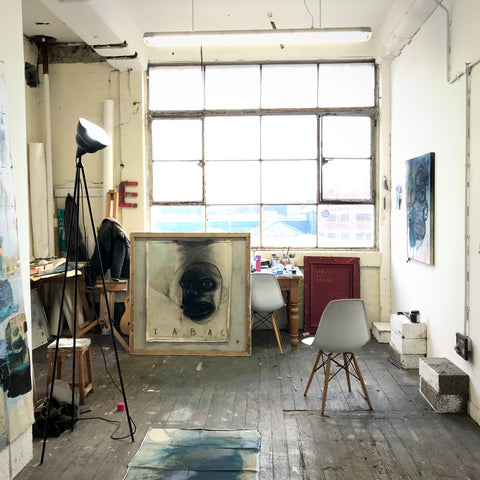
Unfortunately, I have had to recognise that although I work alone in my studio I have to do my bit and stay at home, and find other ways to make work for the time being.
Kim: Is the current isolation given you time to do or make something new?
Stewart: The lockdown has enabled me to rediscover the joys of drawing digitally with a stylus straight onto my iPad. There’s no mess to clean up and I can produce work whilst lounging on the sofa! I’ve started producing a series of images based on ancient deities that I hope to compile into a little picture book.
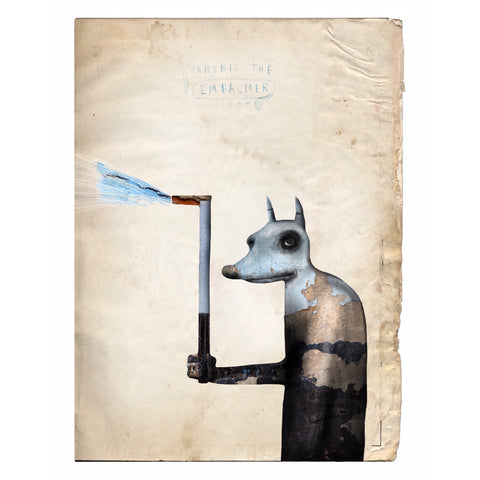
You can browse Stewart Swan's full collection of work here.
Share this post
- 0 comment
- Tags: Artist Interview, artist studio, basquiat, glasgow, mixed-media art, rauschenberg, Stewart Swan

